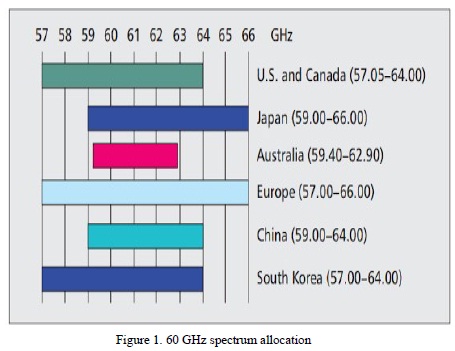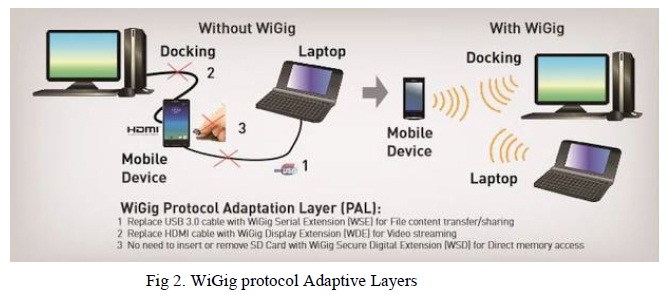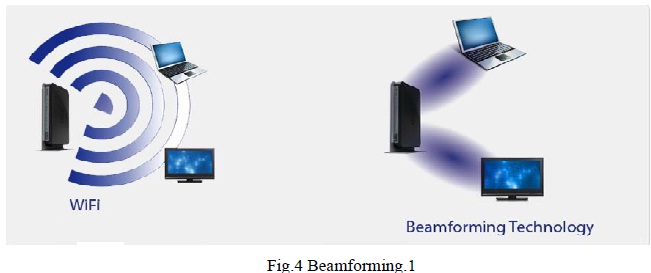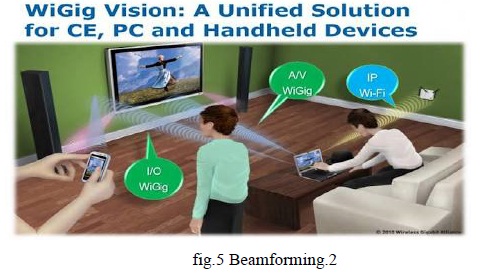





Published on Apr 02, 2024
Wireless Gigabit (WIGIG) network is a development and promotion of high speed wireless communications in the 60 GHz band technology. The demand for higher data transmission rates and advances in the 60 GHz band technology are the keys for this new technology. WiGig technology uses 60 GHz band, where the availability of higher bandwidth in this band range and dependence on Beamforming function makes WiGig more than 10 times faster while comparing with the previous wireless communication technologies even during long distance communications. This paper mainly focuses on the two performance parameters like security, high speed analysis of WIGIG technology.
Keywords- WIGIG, 60GHz band communications, Adaptive Beamforming, millimeter waves.
This paper focuses on super WiFi such as WiGig solution. The Wireless Gigabit (WiGig) Alliance was formed for supporting advanced applications like wireless display, docking, as well as network access. The WiGig, MAC and PHY Specification enables data rates up to 7 Gbps, more than 10 times the speed of the fastest Wi-Fi networks . 60 GHz; new devices with tri-band radios will be able to seamlessly integrate into existing 2.4 GHz and 5 GHz Wi-Fi networks [3]. The specification supports for manyadvanced uses like wireless docking and connection to displays, virtually instantaneous wireless backups, synchronization and file transfers between computers and handheld devices.
The WiGig specification includes key characteristics to maximize performance, minimize implementation complexity and cost, enable compatibility with existing Wi-Fi and provide advanced security. Key features include:
1. Support for data transmission rates up to 7 Gbps; all devices based on the WiGig specification will be capable of gigabit data transfer rates.
2. Designed to support low-power handheld devices such as cell phones, as well as highperformance devices such as computers; includes advanced power management.
3. Support for beam forming, maximizing signal strength and enabling robust communication at distances beyond 10 meters.
4. Support for high-performance, wireless implementations of HDMI, Display Port, USB and PCs.
Utilizing the wider, less congested 60 GHz unlicensed spectrum, WiGig is a directional, line-ofsight technology that provides for multi-gigabit data transfer capability, supporting data rates up to 8 Gbps. WiGig complements Wi-Fi CERTIFIED ac and increases network performance, resulting in better use of network resources and rivaling wired connections. Leveraging a new frequency band with WiGig technology allows for maximum throughput, low latency user experiences. The key benefits of WiGig are:
Ultra-wide channels in the millimeter wave bands enable faster data rates up to 8 Gbps, offering extremely high transmission speeds at ranges up to 10 meters (32.8 feet). • Low latency: The 60 GHz spectrum provides greater bandwidth to enable real-time data transfer.
Wide range of operating modes in 60 GHz provides flexibility between battery life and performance making it suitable for a wide array of usages, such as handsets and VR headsets.
Beamforming reduces link interference, using multiple antennas and directional communication to overcome signal decay and allow greater spectral reuse.
Devices and applications dynamically switch between 2.4, 5, or 60 GHz depending on application and environmental conditions.
WiGig technology works by leveraging the 60 GHz unlicensed spectrum for short-range, multigigabit data transfer. Though local regulatory bodies determine regional spectrum allocation, WiGig is generally available in at least one band in all geographical areas (Figure A). In the United States, all six channels are fully available.

The 60 GHz band has much more spectrum available than the 2.4 GHz and 5 GHz bands combined. Many regions provide at least 8 GHz of spectrum, and up to 14 GHz in the United States, compared with 83.5 MHz in the 2.4 GHz band. As with the 2.4 and 5 GHz bands, the 60 GHz spectrum is divided into multiple channels. At 60 GHz, each channel is 2.16 GHz wide – more than 10 times wider than the channels available in the most renhancements to 802 ad

Uses directional antennas to reduce interference and focus a signal between two devices into a concentrated “beam.” This allows for robust multi beamforming process, devices establish communication and then fine settings to improve the quality of directional communication and minimize contention with adjacent communications, which maximizes link performance and overall system spectral effiency.
Beamforming using directional antennas is to focus the signal on a concentrated “beam”. Wireless Gigabit to overcome the loss of signal uses a process called Adaptive Beamforming.This is not the first or only system to do but it is very dependent on it. Wi combination of physical antennas on devices and algorithms to tune the signal equipment WiGig effectively shoot their signals back and forth at each other in a narrow, directed beam. Antennas in the device, say, router device in case of a device that wants to use a combination of 60GHz is applied to this area, it begins to communicate with the antenna to tune the antenna to maximize signal speed. Antennas do this by adjusting both the amplitude and Reception is optimized by minimizing all kinds of problems: confusion between the antenna and the output expected, for example, the signal to noise ratio.

When the phase shifts and amplitudes of multiple sources waves are manipulated to cooperate and combine their pings properly form the “leaves” excellent reception. The 60 GHz stations need to find each other, coordinate operation, and optimize antenna settings in an efficient, interoperable manner. WIGIG addresses these challenges in its MAC/PHY specification with the design of its network architecture, access protocol, and PHY layer. A specific beam forming protocol is also an integral part of the specification. The WIGIG MAC and PHY layers provide similar functionality to the IEEE 802.11a/b/g/n MACand PHY, but incorporate new features to enhance operation in the 60 GHz band. As mentioned earlier, beamforming is an integral part of the specification.

There is a protocol to allow devices with directional antennas to discover each other and establish connections. Once connected, they can refine antenna settings to maximize transmit and receive gains. As channels change, they can make continuous adjustments to their antenna settings to maximize performance. This allows the highest data rates possible, even with time varying channels, such as those seen by mobile devices.
WiGig helps bring the wireless office closer to fruition, allowing a number of peripherals to be connected without wires and without compromising quality. Employees giving presentations can wirelessly connect their laptop or smartphone to the company’s projection system, eliminating the need to use cumbersome wires and adapters. Individuals who want to show their photos on a larger screen can wirelessly connect their camera directly to their computer or tablet.
WiGig advances the multimedia entertainment experience. Since most entertainment experiences like home theaters and gaming occur in the same room, WiGig is a perfect fit to give a high speed, low latency experience. Multi-player gaming with WiGig releases players from the standard clientserver architecture and offers the opportunity to network directly with other players. Using WiGig, individuals can play together in the same room without perceived latency, which detracts from an immersive gaming experience. WiGig technology can deliver extremely high frame rates and uncompressed high definition (HD) streams for an unparalleled gaming or HD movie viewing experience. Players can see graphics and animations as intended, without latency.
The augmented reality/virtual reality (AR/VR) industry is growing at a tremendous pace in a variety of markets. Though still evolving, most AR/VR applications today remain dependent on a wired connection to a PC or dependent on a smartphone’s cellular connectivity. These applications require very low latency, high definition rendering of minimally compressed or uncompressed formats. WiGig can deliver the in-room performance required to untether these applications, giving a more immersive experience and helping to extend the AR/VR audience.
Travelers can download movies before leaving the house or while rushing through the airport. WiGig opens new opportunities for public kiosk applications by allowing users to obtain products and services quickly, securely, and wirelessly. A WiGig-enabled movie kiosk at an airport could potentially serve several customers simultaneously, sending multiple 10- gigabyte movies in a manner of seconds.
Multi-band access point deployments that include 60 GHz support will dramatically increase Wi-Fi capacity within the enterprise. These deployments provide general connectivity to users, while also creating the ability to process high throughput for bandwidth intensive applications. Offloading multimedia streams and large file downloads creates a more efficient network throughout the enterprise.
WiGig provides significant user benefits in a variety of ways, some of which are transformational in the very nature of how users will interact with WiGig enabled devices. The benefits of using this technology span many markets, from mobile and PC to consu electronics and service provider segments. WiGig is available worldwide in the unlicensed 60 GHz spectrum and increases bandwidth, throughput, and network capacity. Expectations are that 2017 will see steady growth in commercially available WiGig de with more growth year over year (see chart). The use of multi rise and new applications for its utilization, which span multiple industries and market segments, will develop. By 2021, 4.7 billion cumulative WiGig devices introduced into the market
This paper explains WiGig, by obtaining the most recent information about WiGig.WiGig triband enabled devices, which operate in the 2.4, 5 and 60 GHz bands, will deliver data transfer rates up to 7 Gbit/s which is almost seven times faster than 802.11acand ten times faster than the highest 802.11nrate. Basically WiGig is going to help us in syncing file transfers, docking, and streaming videos. Wigig is 10 times faster than the wifi but it does not replace the wi-fi. WiGig is something completely different. It’s a fast, short-hauls service at 60 GHz that is meant to replace local area networks.
Our analysis showed that the performance of WIGIG is much higher in terms of data rates, security. When compared with all other existing wireless communications. Higher data rates are provided by the higher bandwidth available in the 60GHz spectrum band. Higher data rates are achieved even during the long distance communications because of the major dependence on Beamforming. Stronger security is provided by the usage of WPA2 / AES security technology. The advanced features in the WIGIG shows that the future wireless communications will be dominated by the 60GHz Wireless Gigabit.
[1] T. Seki, N. Honma, K. Nishikawa, and K. Tsunekawa, “A 60-GHz multilayer parasitic microstrip array antenna on LTCC substrate for system-on-package,” IEEE Microw. Wireless Compon. Lett., vol. 15, no. 5, pp. 339–341, May 2005.
[2] http://wirelessgigabitalliance.org/news/wigig-to-test-specifications-with-secondtechnology- lugfest.
[3] http://www.rcrwireless.com/americas/20120516/componets/challenges-and-opportunities for-wigig/..
[4] Wireless Gigabit Alliance [Online]. Available:
[5] Swati M. Chandurkar , Dr. Gageendra R. Bamnote “ WiGig – The Wireless Technology ”
[6] “HighRate 60 GHz PHY, MAC and HDMI PALs,” ECMA International, December 2010.
[7] R. C. Daniels and J. Robert W. Heath, “60 GHz wireless communi-cations: emerging requirements and design recommendations,” IEEE Vehicular technology magazine, pp. 41– 50, September.
[8] C. J. Hansen, “WiGig: Multi-gigabit wireless communications in the 60 GHz band,” IEEE Wireless Communications
| Are you interested in this topic.Then mail to us immediately to get the full report.
email :- contactv2@gmail.com |